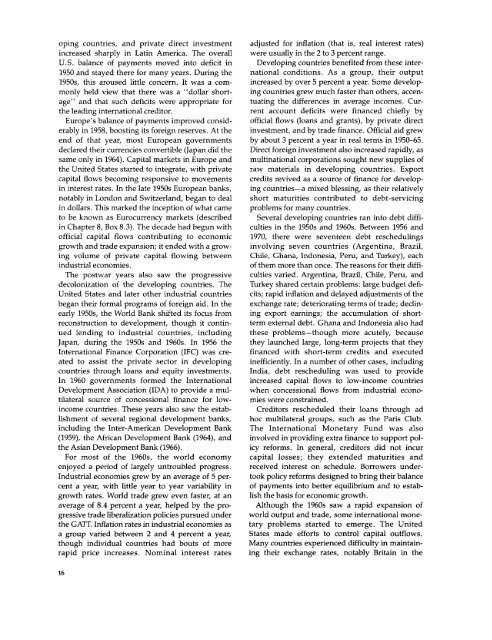World Bank Document
World Bank Document
World Bank Document
Create successful ePaper yourself
Turn your PDF publications into a flip-book with our unique Google optimized e-Paper software.
oping countries, and private direct investment adjusted for inflation (that is, real interest rates)<br />
increased sharply in Latin America. The overall were usually in the 2 to 3 percent range.<br />
U.S. balance of payments moved into deficit in Developing countries benefited from these inter-<br />
1950 and stayed there for many years. During the national conditions. As a group, their output<br />
1950s, this aroused little concern. It was a com- increased by over 5 percent a year. Some developmonly<br />
held view that there was a "dollar short- ing countries grew much faster than others, accenage"<br />
and that such deficits were appropriate for tuating the differences in average incomes. Curthe<br />
leading international creditor.<br />
rent account deficits were financed chiefly by<br />
Europe's balance of payments improved corisid- official flows (loans and grants), by private direct<br />
erably in 1958, boosting its foreign reserves. At the investment, and by trade finance. Official aid grew<br />
end of that year, most European governments by about 3 percent a year in real terms in 1950-65.<br />
declared their currencies convertible (Japan did the Direct foreign investment also increased rapidly, as<br />
same only in 1964). Capital markets in Europe and multinational corporations sought new supplies of<br />
the United States started to integrate, with private raw materials in developing countries. Export<br />
capital flows becoming responsive to movements credits revived as a source of finance for developin<br />
interest rates. In the late 1950s European banks, ing countries-a mixed blessing, as their relatively<br />
notably in London and Switzerland, began to deal short maturities contributed to debt-servicing<br />
in dollars. This marked the inception of what came problems for many countries.<br />
to be known as Eurocurrency markets (described Several developing countries ran into debt diffiin<br />
Chapter 8, Box 8.3). The decade had begun vvith culties in the 1950s and 1960s. Between 1956 and<br />
official capital flows contributing to economic 1970, there were seventeen debt reschedulings<br />
growth and trade expansion; it ended with a grow- involving seven countries (Argentina, Brazil,<br />
ing volume of private capital flowing between Chile, Ghana, Indonesia, Peru, and Turkey), each<br />
industrial economies.<br />
of them more than once. The reasons for their diffi-<br />
The postwar years also saw the progressive culties varied. Argentina, Brazil, Chile, Peru, and<br />
decolonization of the developing countries. The Turkey shared certain problems: large budget defi-<br />
United States and later other industrial countries cits; rapid inflation and delayed adjustments of the<br />
began their formal programs of foreign aid. In the exchange rate; deteriorating terms of trade; declinearly<br />
1950s, the <strong>World</strong> <strong>Bank</strong> shifted its focus from ing export earnings; the accumulation of shortreconstruction<br />
to development, though it contin- term external debt. Ghana and Indonesia also had<br />
ued lending to industrial countries, including these problems-though more acutely, because<br />
Japan, during the 1950s and 1960s. In 1956 the they launched large, long-term projects that they<br />
International Finance Corporation (IFC) was cre- financed with short-term credits and executed<br />
ated to assist the private sector in developing inefficiently. In a number of other cases, including<br />
countries through loans and equity investments. India, debt rescheduling was used to provide<br />
In 1960 governments formed the International increased capital flows to low-income countries<br />
Development Association (IDA) to provide a mul- when concessional flows from industrial econotilateral<br />
source of concessional finance for low- mies were constrained.<br />
income countries. These years also saw the estab- Creditors rescheduled their loans through ad<br />
lishment of several regional development banks, hoc multilateral groups, such as the Paris Club.<br />
including the Inter-American Development <strong>Bank</strong> The International Monetary Fund was also<br />
(1959), the African Development <strong>Bank</strong> (1964), and involved in providing extra finance to support polthe<br />
Asian Development <strong>Bank</strong> (1966).<br />
icy reforms. In general, creditors did not incur<br />
For most of the 1960s, the world economy capital losses; they extended maturities and<br />
enjoyed a period of largely untroubled progress. received interest on schedule. Borrowers under-<br />
Industrial economies grew by an average of 5 per- took policy reforms designed to bring their balance<br />
cent a year, with little year to year variability in of payments into better equilibrium and to estabgrowth<br />
rates. <strong>World</strong> trade grew even faster, at an lish the basis for economic growth.<br />
average of 8.4 percent a year, helped by the pro- Although the 1960s saw a rapid expansion of<br />
gressive trade liberalization policies pursued under world output and trade, some international monethe<br />
GATT. Inflation rates in industrial economies as tary problems started to emerge. The United<br />
a group varied between 2 and 4 percent a year, States made efforts to control capital outflows.<br />
though individual countries had bouts of more Many countries experienced difficulty in maintainrapid<br />
price increases. Nominal interest rates ing their exchange rates, notably Britain in the<br />
16

















